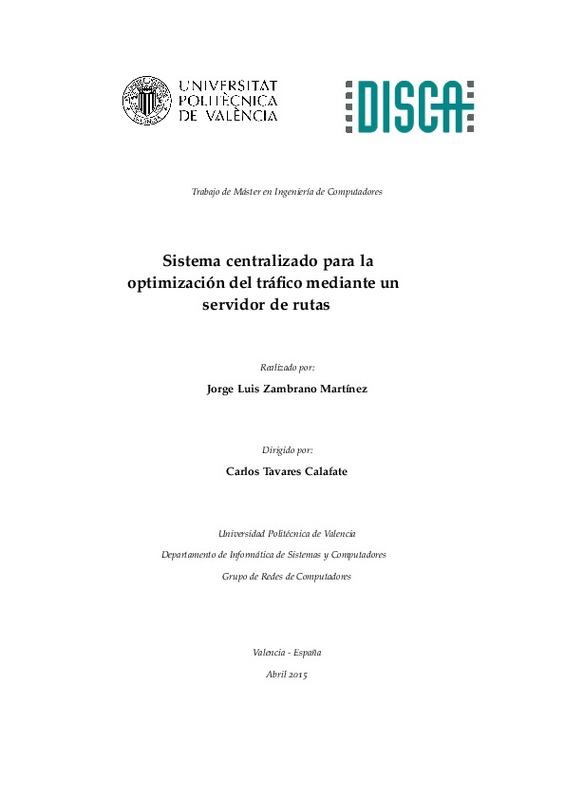JavaScript is disabled for your browser. Some features of this site may not work without it.
Buscar en RiuNet
Listar
Mi cuenta
Estadísticas
Ayuda RiuNet
Admin. UPV
Sistema centralizado para la optimización del tráfico mediante un servidor de rutas
Mostrar el registro sencillo del ítem
Ficheros en el ítem
| dc.contributor.advisor | Tavares de Araujo Cesariny Calafate, Carlos Miguel
|
es_ES |
| dc.contributor.author | ZAMBRANO MARTINEZ, JORGE
|
es_ES |
| dc.date.accessioned | 2016-07-07T09:41:27Z | |
| dc.date.available | 2016-07-07T09:41:27Z | |
| dc.date.created | 2015-04-20 | |
| dc.date.issued | 2016-07-07 | |
| dc.identifier.uri | http://hdl.handle.net/10251/67300 | |
| dc.description.abstract | [EN] The route planning solutions promise improvements in terms of the travel time for a route if they are familiar with the traffic congestion state in real-time. With current solutions, where most are static and based on, the cost of road segments, the first challenge is to obtain reliable estimates of traffic congestion for a city at different times of day, and for different days of the year. Overall, calculating this amount of data will take a long time, and have a high computational cost when evaluating the optimal routes based on dependencies. In this paper, the feasibility of integrating a route recommendation system, a network simulator and a traffic simulator is studied. In particular we study the integration of OMNeT ++ and SUMO, both widely known and used tools, with the ABATIS route server as a solution for route planning, allowing to investigate what are the different effects on vehicle flows densely populated urban areas. To achieve that goal the traffic patterns adopted are adjusted, following driver models ranging from real-time speed changes to changes in route selection. However, the number of vehicles that have to be introduced in the simulation is unknown, and thus we developed a heuristic to adjust the number of vehicles to be injected based on the number of vehicles detected on the different sensors placed along the main streets of Valencia, Spain. Initial results show that the proposed route server offers routes with similar quality compared to the tool integrated in SUMO, and that the use of alternative routes is likely to introduce significant changes on the travel times of vehicles | es_ES |
| dc.description.abstract | [ES] Las soluciones de planificación de rutas prometen lograr mejoras en términos del tiempo recorrido de una ruta si son conocedores del estado de la congestión del tráfico en tiempo real. Con las actuales soluciones, la mayoría toman como base, y de manera estática, el coste de los segmentos de la ruta, siendo el primer reto obtener estimaciones de la congestión de tráfico fiables para las vías de una ciudad en distintas horas del día, y para los distintos días del año. En general, calcular esta cantidad de datos llevará mucho tiempo, y tendrá un elevado coste computacional al evaluar las rutas óptimas en base a dependencias. En este trabajo se estudiará la viabilidad de integrar un sistema de recomendación de rutas con un simulador de red y un simulador de tráfico. Concretamente, se desarrolla la integración de OMNeT++ y SUMO, ambos herramientas muy conocidas y utilizadas, con el servidor de rutas ABATIS como solución a la planificación de rutas, permitiendo así investigar cuales son los diferentes efectos sobre los flujos de vehículos en zonas urbanas densamente pobladas. Para eso se ajustan los patrones de tráfico, siguiendo modelos de conducción en tiempo real que van desde cambios de velocidad a cambios en la selección de rutas. Sin embargo, se desconoce la cantidad de vehículos que tienen que ser introducidos en la simulación y, por lo tanto, se desarrolló una heurística para ajustar la cantidad de vehículos a inyectar partiendo de la cantidad de vehículos que pasan por los detectores colocados en las distintas vías de Valencia, España. Resultados iniciales muestran que el servidor de rutas propuesto ofrece rutas con calidad similar a la herramienta integrada en SUMO, y que el uso de rutas alternativas es propenso a introducir cambios notables en los tiempos de recorrido de los vehículos | es_ES |
| dc.format.extent | 54 | es_ES |
| dc.language | Español | es_ES |
| dc.publisher | Universitat Politècnica de València | es_ES |
| dc.rights | Reconocimiento - No comercial - Sin obra derivada (by-nc-nd) | es_ES |
| dc.subject | Redes vehiculares | es_ES |
| dc.subject | Interfaz | es_ES |
| dc.subject | ABATIS | es_ES |
| dc.subject | OMNeT++ | es_ES |
| dc.subject | SUMO | es_ES |
| dc.subject | Vehicular network | es_ES |
| dc.subject | Interface | es_ES |
| dc.subject.classification | ARQUITECTURA Y TECNOLOGIA DE COMPUTADORES | es_ES |
| dc.subject.other | Máster Universitario en Ingeniería de Computadores-Màster Universitari en Enginyeria de Computadors | es_ES |
| dc.title | Sistema centralizado para la optimización del tráfico mediante un servidor de rutas | es_ES |
| dc.type | Tesis de máster | es_ES |
| dc.rights.accessRights | Abierto | es_ES |
| dc.contributor.affiliation | Universitat Politècnica de València. Servicio de Alumnado - Servei d'Alumnat | es_ES |
| dc.description.bibliographicCitation | Zambrano Martinez, J. (2015). Sistema centralizado para la optimización del tráfico mediante un servidor de rutas. http://hdl.handle.net/10251/67300 | es_ES |
| dc.description.accrualMethod | Archivo delegado | es_ES |






